With such a scientific-sounding name it may surprise you that you probably come into contact with products containing some sort of polypropylene multiple times a day. How curious to think that the same polymer used commonly to make things such as food packaging, the bottle that holds your shampoo, and medical equipment can be the same polymer used to make a fabric that is often used to produce blankets and sheets, your reusable grocery bags, and upholstery. With such a wide range of applications, I’m sure you are left wondering – what is polypropylene fabric, anyway?
Polypropylene fabric is a term that describes any textile that is made from the synthetic thermoplastic polymer polypropylene, also referred to as PP. Polypropylene is the second most widely produced plastic in the world, after polyethylene. While polypropylene is most commonly used in the production of food packaging, straws, and other industrial goods, polypropylene fabric can also often be found in upholstered furniture, backpacks, performance wear, and other apparel.
You may never before have realized what a versatile textile polypropylene is! In this article, we will cover how polypropylene fabric is produced, and what its many properties and uses are. You’ll also learn about the pros and cons of using polypropylene material as well as the differences between PP and other synthetic fabrics, such as polyester and nylon.
Quick Navigation
- What is Polypropylene Fabric?
- What is Polypropylene Made of?
- Properties of Polypropylene Fabric
- What is Polypropylene Fabric Used For?
- Can Polypropylene Fabric be Washed?
- Is Polypropylene Waterproof?
- Is Polypropylene Good for Upholstery?
- Are Polypropylene Fabrics Safe?
- Is Polypropylene the Same as Polyester?
- What Is PP Cotton?
- Is Polypropylene Like Nylon?
- Pros and Cons of Polypropylene Material
- Polypropylene Fabric by the Yard
- Conclusion
What is Polypropylene Fabric?
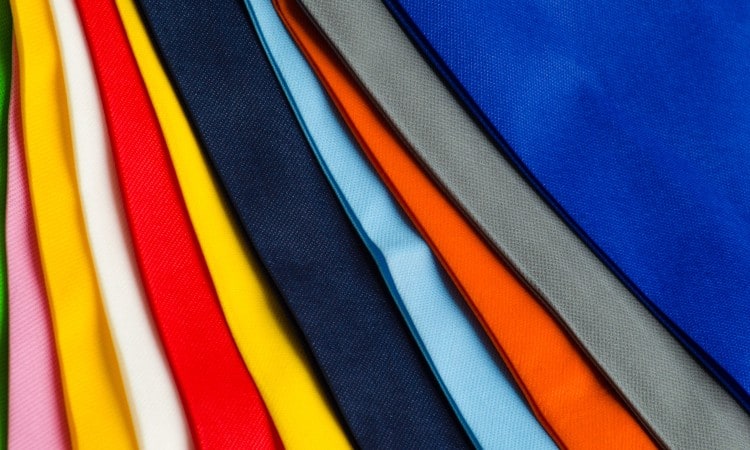
Polypropylene fabric is a fully synthetic, flexible textile that has many, many uses. It is created from a thermoplastic polymer that is produced through chemical and heat processes. Polypropylene fabric can be found in both woven and non-woven types.
Woven polypropylene is created just as it sounds, with polypropylene threads being woven together, similar to other traditional woven fabrics. In contrast, non-woven polypropylene fabric is bonded together using heat. While both processes create a product that is durable and versatile, the manufacturing of non-woven polypropylene fabric eliminates much of the work, and therefore cost that goes into production.
What is Polypropylene Made of?
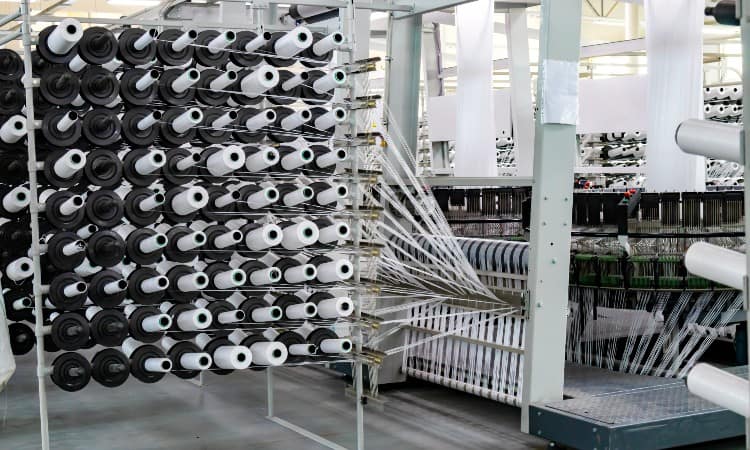
Polypropylene fabric is a textile made from thermoplastic polymer polypropylene, also known as PP. It is a non-polar, partially crystalline plastic from the group polyolefin. This hydrocarbon polymer is one of the most widely produced plastics in the world and keeps its popularity up due to its cost efficiency and ease of manufacturing.
Polypropylene was originally created in the early 1950’s when the oil and gas company, Phillips Petroleum, was researching gasoline production and came out with this thermoplastic by accident. As its popularity increased, the value of its use as a textile became apparent and processes were developed to create both woven and non-woven PP fabrics.
Polypropylene is derived from hydrocarbon fuels, such as petroleum oil. The monomer is extracted from the crude oil in the form of a gas and then put through the process of chain-growth polymerization, creating the polymer polypropylene.
A solid plastic material is formed when a bunch of these monomers are put together, which then must be combined with additional fillers, stabilizers, and colorants in order to produce a usable fabric. These additives generally come out to no more than 2% of the final composition.
Once the desired mixture is achieved, the plastic is transformed at textile factories into sheets of thin fibers that can be cut and sewn or bonded together, or by remelting, pressing, and molding into the desired shape. Regardless of the manufacturing process, polypropylene fabric is one of the most versatile textiles on the market, and nowadays, PP plays a significant role in a multi-billion dollar global industry!
Properties of Polypropylene Fabric
Polypropylene fabric has so many useful properties it is no wonder that it is an ideal candidate for such a wide range of applications. Some of the properties that make polypropylene such a useful textile are that it’s flexible while remaining durable, but also lightweight and breathable. Polypropylene fabric is also stain resistant, and resists fading and water absorption as well.
One of the major advantages of PP fabric is its moisture-wicking property. Since Polypropylene is essentially made from plastic, it is actually unable to absorb any moisture at all. This means that instead of the fabric becoming wet when it comes in contact with moisture, any moisture moves right through the PP fabric instead.
Another feature that makes PP so useful as a textile is its incredible chemical resistance. Polypropylene is resistant to most acids and alkalis, meaning that it can be cleaned quite easily; even with some pretty harsh chemical cleaners, such as bleach, polypropylene fabric can retain its integrity. Due to its synthetic nature, you also don’t have to worry about moths or other insects, or mold or fungi damaging your PP items.
Although PP is abrasion resistant, can hold up to bleach, and resists stains and fading, it can tend to absorb and hold onto odors. Also, due to its thermoplastic composition, polypropylene fabric is sensitive to UV exposure and can melt at relatively low temperatures, which may create some cause for concern in certain circumstances.
At the same time, polypropylene’s capacity to be melted does play a role in its ability to be recycled. As for its color retention, due to the method with which polypropylene is colored, which is done at high heat when the PP is in its melted form, it is extremely color fast.
What is Polypropylene Fabric Used For?
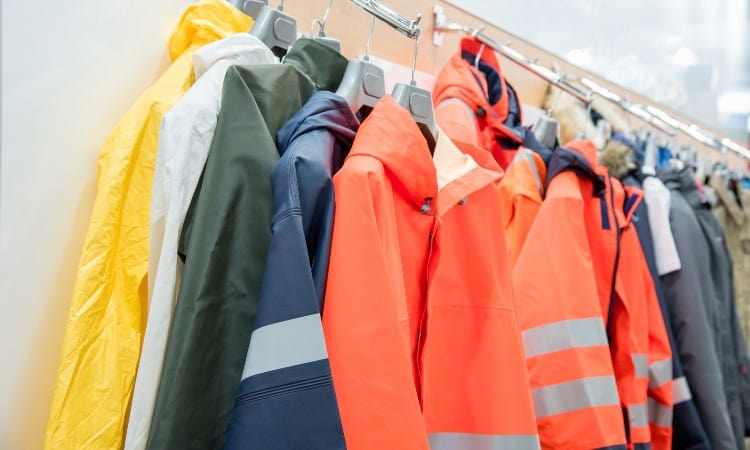
Due to its many versatile properties, polypropylene has an exhaustive list of uses! Many household items, including baby wipes and diapers that rely on PPs incredible moisture-wicking ability. Plus, the reusable grocery bags we bring to the market, and the oh-so-familiar medical face masks we’re all used to wearing are composed of polypropylene fabric.
Specifically non-woven polypropylene fabric is an ideal material to use in the manufacturing of outdoor gear due to its moisture-wicking, non-absorbent yet breathable characteristics. Its durability and stain resistance are another reason PP makes such a great fabric for this use.
Polypropylene’s ability to transfer moisture also makes it a desirable fabric for athletic and sportswear. But the combination of PP fabric holding onto odors while also not being able to wash at very high temperatures, due to its meltability, has led to other textiles becoming more popular in this category.
Polypropylene fabric is used widely for luggage such as duffle and tote bags, as well as sturdier suitcases. Thanks to its versatility, it’s also used for upholstery due to its stain and fade resistant characteristics, ease of cleaning, and durability.
Can Polypropylene Fabric be Washed?
Even with its stain and mildew resistant properties, there is sure to be a situation where you will need to wash your Polypropylene fabric items. Thankfully, because of its low absorption capability, this should not be an incredibly difficult task. Keeping up with the care of your textile products will help make cleaning easier in the long run, and is also sure to increase their lifespan, which is another plus for you.
PP fabric can be washed with a couple of different methods, just remember, it should never be washed in hot water due to its thermoplastic composition making it prone to melting. You don’t want to ruin the item you’re trying to clean or damage your washing machine! Always check care labels, if available, to be sure that you are using the best method for the particular item.
Spot Cleaning
Spot cleaning is a quick and easy way you can keep your polypropylene fabric items clean, especially the non-garment products. Simply wipe with an antibacterial wipe and allow it to dry. Alternatively, or if you’re trying to remove a larger or peskier stain, you can use a mixture of cool or lukewarm water and either dish soap or a mild laundry detergent.
Dip a towel in the soapy mixture and apply to the area that needs to be cleaned. Rub the area, repeating the process as necessary until the item is sparkling clean. Allow the item to dry and it will be as good as new.
Hand Wash
If you need to wash an entire garment or item made from PP fabric, the best way to do so is by hand washing it in the sink. Fill your sink with cool or lukewarm water and mix in some dish soap or mild laundry detergent.
Submerge the item that needs cleaning and gently agitate with your hands until it is clean. Drain the sink and rinse until all the soap has come out, then allow to dry.
Washing Machine
When using a washing machine to clean polypropylene fabric, it is important to use cold water. The water temperature should never be above 104℉. Use a mild detergent and a gentle setting. It is also a good idea to place the item in a wash bag to help keep all of those microfibers in place and out of the wastewater!
Drying
After your polypropylene items are fresh and clean, you might wonder what the best method for drying them is, especially with their notorious sensitivity to heat. Air drying is the gentlest method, which will always keep your items in great shape.
What if you need the item fast and don’t want to wait for nature to do its job? You’re in luck! You can actually put polypropylene fabric items in the dryer! Toss the item into the dryer and make sure to use the line dry, tumble or air fluff setting. Double check that setting…you never want to overheat your PP fabric in the dryer!
Is Polypropylene Waterproof?
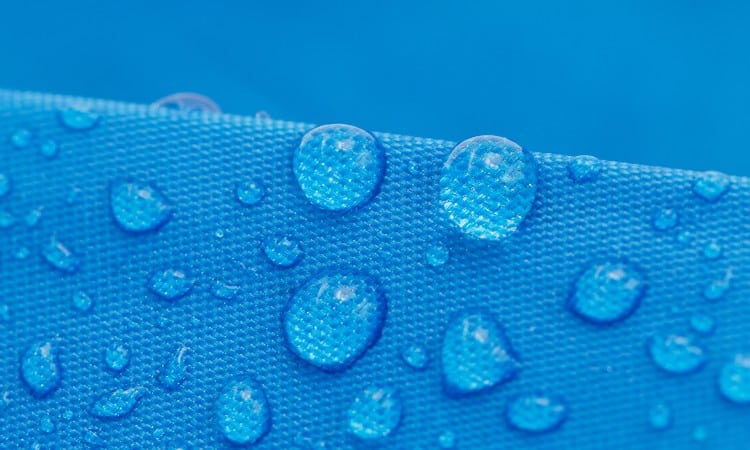
With all that talk about its incredible moisture-wicking abilities, you’ve probably been wondering if polypropylene is completely waterproof. And the answer, generally speaking, is yes, or, it can be…
Since polypropylene can be produced in many different ways, and there are tons of different types of end products made from PP, it wouldn’t be accurate to say that polypropylene being waterproof is always the case, but polypropylene textiles are often used to make waterproof products.
The type and method of production of the polypropylene fabric are what determine its waterproof abilities. Of course, polypropylene on its own is non-absorbent, making it water resistant in just about any form. Plus, its versatility in regard to the level of waterproofing/breathability you can create with PP fabric makes it an ideal textile for these products.
For waterproof abilities in regard to woven PP fabric, the tighter the weave, the more waterproof the item will be. Less water will be able to permeate through a fabric that is woven extremely tight. A laminate finish can also be applied to woven PP fabrics, making them completely waterproof, but unfortunately this also takes away the innate breathability of the fabric.
Non-woven polypropylene is produced with such a great variety of methods and end products that it is even more versatile in its range and ability to be waterproof. However, like woven polypropylene fabric, non-woven PP can also be treated with coatings that can create an incredibly waterproof product.
There are also plenty of polypropylene fabric products out there, those made out of loosely woven PP, that when hit with water will allow the moisture to slip right through. This is an important thing to consider, depending on what you are looking for the fabric to do.
You can always test how waterproof the fabric you are working with is by splashing some water onto it. If the water soaks right through, the fabric obviously won’t make a great rain jacket. If it beads up on top of the fabric instead, you have a sure sign that you are working with a textile that has, at least some level of waterproof capability.
Is Polypropylene Good for Upholstery?
Many of polypropylene’s characteristics make it an ideal textile for upholstery. You don’t want your couch to fade or be easily susceptible to stains. You’d like it to last at least several years, and by that time look as close to as good as the day you bought it. Well, polypropylene can achieve much of that.
As explained earlier, polypropylene does not soil easily, and when it does, spills and stains cannot soak into the material itself. When a spill does land on your PP upholstered item it will be easy to clean without the worry of the fabric being compromised, due to its color fast properties even when using bleach.
As a synthetic material that is manufactured with ease, polypropylene is also considered very affordable. Therefore, polypropylene fabric can provide a great and versatile option for anyone with a lower budget. That being said, even though polypropylene may be resistant to wrinkles and fading, if it is blended with certain of its synthetic fiber relatives, it can be more prone to pilling after a shorter period of time than with a natural fiber such as cotton or linen.
Are Polypropylene Fabrics Safe?
The short answer to the question whetherpolypropylene fabric is safe is yes. But, with such an array of manufacturing procedures and end products, again, it’s not that simple. While you should always limit your use of plastics and opt for more natural alternatives whenever possible, the Environmental Protection Agency (EPA) does consider polypropylene to be a safer choice than some other types of plastic.
However, plastics, in general, are pretty complex, and there is a chance that there may be some level of toxicity present. As with all types of plastic, there can be numerous chemical additives that will likely not be disclosed on the product label, making it impossible to know exactly what you are putting into your environment.
What about the environment anyway? While some might say that polypropylene is more environmentally friendly than other plastics, that doesn’t mean it’s good for our planet. Overall, the production of polypropylene does have a negative impact on the environment.
Many toxic chemicals are used in the production of polypropylene, many of which can contaminate water and air in the surrounding areas, as well as a significant amount of waste being produced alongside the final product. We also can’t forget that PP is derived from petroleum, a fossil fuel that just so happens to be a limited resource.
While polypropylene fabric is not considered biodegradable, it takes hundreds of years for PP items to break down completely in nature. The good news is that many of its forms have the potential to be reusable or recyclable. Whether or not that takes place, is another story.
Is Polypropylene the Same as Polyester?
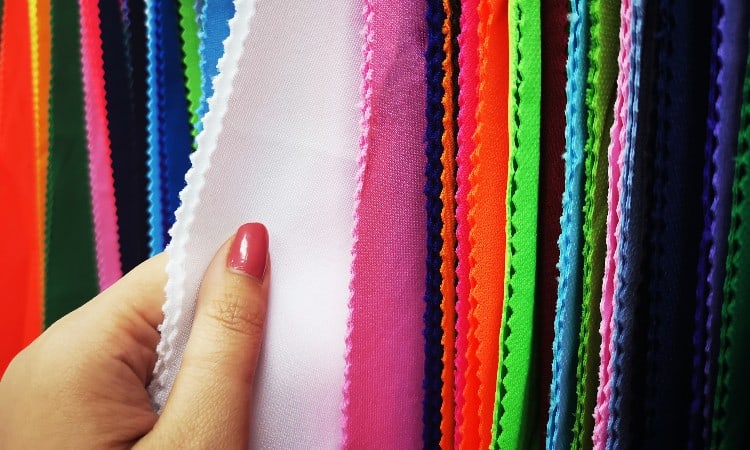
Polyester is another synthetic fiber that is made from plastic. While it does share some of the same qualities as polypropylene, there are some key differences that make it clear that the two are not the same thing.
Though polyester is derived from plastic and is non-biodegradable, just like polypropylene, it is produced in a completely different manner, contributing to each its unique makeup and characteristics, and making each better suited for different end uses.
Take a look at the list below to see some of the main differences between polyester and polypropylene:
Moisture Absorbency
While both fabrics have good moisture-wicking capabilities, polypropylene is much more water-resistant. It is used more often for waterproof products, dries more quickly, and retains more heat.
Durability
As synthetic textiles, both polyester and polypropylene are durable fabrics. However, with its non-porous properties, polypropylene’s ability to ward off stains may make it more lasting in the long run.
Unlike polypropylene, polyester can be dyed after production, meaning that it may not be as colorfast as its counterpart. Making it more susceptible to harsh chemicals, as well as being affected by bleach, unlike PP. Polypropylene is also known to break down quickly with UV exposure, while polyester can hold up much better to prolonged time in the sunlight.
Care
While it’s not terribly difficult to care for your polypropylene items due to their stain resistance, there are a few extra precautions you need to consider with its care, namely the exposure to high heat. Polyester, on the other hand, can easily be thrown in the wash as well as giving you the option to dry clean.
Uses
The apparel industry uses an obscene amount of polyester each year, accounting for around 32 million tons! It is the most widely used fiber in the apparel industry, making up over 50% of the fiber market overall and close to 80% when looking at synthetics alone! polypropylene has an abundance of uses ithas nowhere near the significance that polyester holds in the apparel industry.
What Is PP Cotton?
PP cotton, also known as polycotton, is a fabric blend that is made from cotton and polyester. Combining the best characteristics of each to get the best of both worlds. Cotton is a highly sought-after natural fiber. It is soft, breathable, and versatile. It can also be more subject to wear-and-tear and tends to be somewhat expensive. Enter the polyester fibers.
PP cotton is a blend of both natural and synthetic fibers. The specific content of each can vary but tends to contain at least 50% cotton, which combines the advantages of each into one material. PP cotton is much more tear-resistant and overall more durable than textiles made of cotton alone. It is more shrink-resistant than 100% cotton items. Cotton is known to shrink with heat, but is relatively easy to care for.
One of the main draws of this combination is that it is much more affordable than 100% cotton. In most cases, it will be more expensive than a fully synthetic material. Some of the not-so-great things about the blend are that the addition of synthetic fibers makes the fabric less breathable and not as soft.
Is Polypropylene Like Nylon?
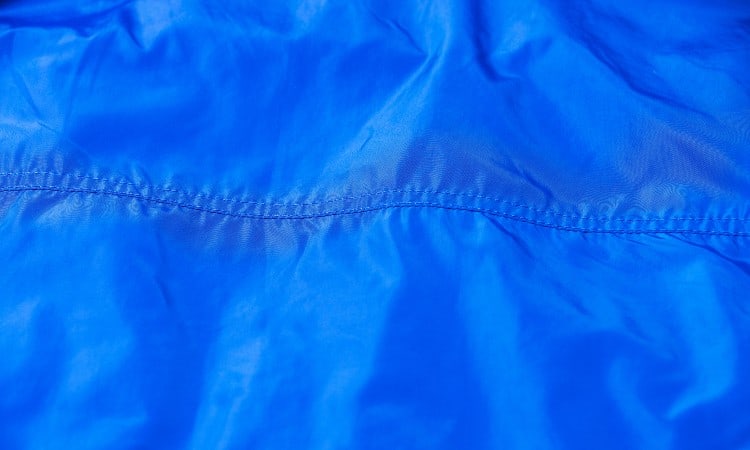
Nylon is yet another synthetic fiber that is derived from plastic, it is often combined with other materials during production. Like polyester and polypropylene, nylon is a synthetic polymer, but its chemical structure is unique lending to its different characteristics.
Although it is another durable synthetic material, nylon does not have nearly the same strength as polypropylene. What it lacks in durability, nylon picks up with its stretch and flexibility. Nylon can also be very soft and smooth and have a sheen or luster to it, making it a great substitute for silk, which is luxurious but also very expensive.
Unlike polypropylene, which does not absorb moisture, nylon has a much higher absorption rate. It is more resistant to UV exposure than polypropylene and much more flexible and stretchy.
Caring for nylon is somewhat similar to that of polypropylene. It does not do well with heat so should be washed in cold water, with a mild detergent on a gentle setting. Don’t forget to always check care labels before washing!
Nylon, like polypropylene, has an abundance of uses, but the first one that pops into your head is far removed from the properties that come to mind when thinking about PP – Nylons themselves! Due to its stretchy properties, nylon is used widely for stockings, tights, and legging, as well as many other apparel-related products.
Pros and Cons of Polypropylene Material
With such a versatile textile, it is obvious that there are some clear advantages and disadvantages that come along with using polypropylene fabric. Check the list below for a quick summary:
Pros
- Polypropylene is relatively easy to produce and in wide production, making it a very affordable option.
- Polypropylene is durable. Its chemical make-up lends to the properties that make it stain-resistant, fade-resistant, and resistant to abrasion.
- As a thermoplastic, polypropylene is hydrophobic, it does not absorb moisture which creates a fabric that is highly permeable, creating great moisture-wicking abilities.
- Polypropylene is very lightweight and breathable, it allows air to flow easily in and out of the fabric.
- Polypropylene’s composition, on its own as well as with additional laminates, makes it a perfect material for items that need to be waterproof.
- Polypropylene does not react to many chemicals, meaning you can use something even as strong as bleach and your items can retain their integrity.
- Polypropylene is resistant to moths and other insects, as well as the growth of mold and other fungi.
- Polypropylene fabric dries quickly.
- Polypropylene has the ability to be recycled numerous times.
Cons
- Polypropylene has a low melting point. It cannot be exposed to high heat without degrading, meaning you must use caution when washing, as well as in other circumstances. It can also be highly flammable.
- UV exposure can degrade polypropylene quickly.
- Polypropylene can absorb and hold onto odors.
- Polypropylene is not great for the environment. It is a hydrocarbon product derived from petroleum, whose production requires the use of a fossil fuel that is a limited resource.
- By-products of polypropylene can contaminate surrounding air and water, as well as create a large amount of waste that degrades soils and contribute to global warming.
- Even though it is possible to recycle polypropylene, in reality, only a very small percentage of polypropylene products are recycled each year.
Polypropylene Fabric by the Yard
Polypropylene is very widely produced in a wide variety of forms. This means that there can also be a variety of costs associated with purchasing PP products. In its plastic, as well as many of its woven and non-woven forms, polypropylene is inexpensive to buy by the yard.
You can find it in many different colors and textures, for purposes that range from use for filters and/or masks, to fabric for weed barriers for your yard, to a wide variety of upholstery fabric options.
However, in regard to fabrics that can be made into apparel, the development and advancement of polyester fabrics have made the demand for many polypropylene textiles decrease, raising the cost for producers, and therefore the consumer as well. Polypropylene fabric in its many types is widely available for purchase by the yard. It can be purchased from fabric stores, Etsy, Amazon, and even Walmart.
Conclusion
Polypropylene is an incredible invention! It can house your bath and shower products, help you get to work or take a road trip by being a big component of your car, wrap the sandwich you ate for lunch, AND keep you warm and dry as a jacket or long underwear.
There is no doubt that the versatility and functionality of polypropylene remain impressive, just remember that it’s always important to keep the environmental impact of the products we use in mind.